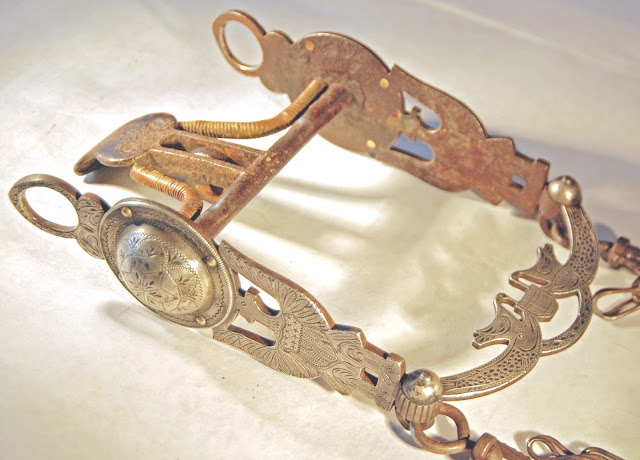"Target Cards / Shot by May Lillie at Pawnee Bill's Show / given to spectator Grandfather Wills / 1912" This description says it all. Six gorgeous antique playing cards are framed around the card bearing that inscription. Each card has precise areas shot out by differing caliber bullets. The cards are beautifully illustrated and all measure 4 1/4inches by 2 1/2 inches. Also in the frame is a cabinet card from Sword's Brothers Professional Photographers in York, PA showing Mae Lillie with her husband, famed Pawnee Bill.
The framed piece measures 29 x 17 1/2. The shot out playing cards and note were glued to a black paper backing by around 1912. The black paper with it's cards and note have been framed unchanged as the lower part of this set. The upper part is an original cabinet card, as shown, of May Lillie and Pawnee Bill. The piece has been professionally framed for archiving on acid-free, museum quality paper and matting, behind glass.
Mae Lillie was a fantastic shot and a contemporary rival of Annie Oakley. "May Lillie, was a sharpshooter with the show as well. May was a graduate of Smith College and the daughter of a prominent Philadelphia physician. She seemed an unlikely candidate to become a sharpshooter, until Lillie brought her, as a young bride, to his Kansas ranch, where he and his cowboy's taught her to shoot and ride sidesaddle. She took readily to her new lifestyle. She went on a hunt with the Pawnees in Indian Territory and killed eight prairie chickens and sixteen wild turkeys in one afternoon. The Indians were so impressed with her skill that they gave her one of their horses, which she named Hunter. May trained Hunter and rode him at Kansas fairs, where she was acclaimed "the most graceful lady rider in the state." When she learned to shoot from Hunter's back, Pawnee Bill put her in his show and billed her as "May Lillie, Princess of the Prairie" and "World's Champion Woman Rifle Shot." May was a small and vivacious woman whose costume in the Wild West arena looked remarkably similar to the ones Annie Oakley wore. But despite that and despite May's claim to the world's championship, Annie apparently got along well with her. They performed on the same bill for a month in the summer of 1888."*
 Gordon Lillie married young and petite May Manning in 1886; May (aka "Mae"; born "Mary") was seventeen years old. In 1888 Gordon and May Lillie launched their own show: Pawnee Bill’s Historic Wild West. Mae starred in the show as the “Champion Girl Horseback Shot of the West.” Their first season was a financial disaster and they re-organized as a smaller operation called “Pawnee Bill’s Historical Wild West Indian Museum and Encampment Show.” The show traveled to Europe, performing in France and Belgium. The show was popular but not lucrative. They returned to the United States and added Jose Barrera to the cast; he was widely popular performing as Mexican Joe. In 1907 Gordon hired performers from a variety of backgrounds. He organized Mexican cowboys, Pawnee and Sioux scouts, Chinese and Japanese performers, and Arab jugglers. The ensemble debuted as the “Pawnee Bill’s Wild West and Great Far East Show.”
Gordon Lillie married young and petite May Manning in 1886; May (aka "Mae"; born "Mary") was seventeen years old. In 1888 Gordon and May Lillie launched their own show: Pawnee Bill’s Historic Wild West. Mae starred in the show as the “Champion Girl Horseback Shot of the West.” Their first season was a financial disaster and they re-organized as a smaller operation called “Pawnee Bill’s Historical Wild West Indian Museum and Encampment Show.” The show traveled to Europe, performing in France and Belgium. The show was popular but not lucrative. They returned to the United States and added Jose Barrera to the cast; he was widely popular performing as Mexican Joe. In 1907 Gordon hired performers from a variety of backgrounds. He organized Mexican cowboys, Pawnee and Sioux scouts, Chinese and Japanese performers, and Arab jugglers. The ensemble debuted as the “Pawnee Bill’s Wild West and Great Far East Show.”
In 1908 rival showman 'Buffalo Bill' Cody’s managing partner, Bailey, died. Cody contacted Gordon and encouraged him to buy Bailey’s share of the show. The "Two Bills" merged shows and became "Buffalo Bill’s Wild West and Pawnee Bill’s Far East" with Gordon as the managing partner. The show was a great financial success. However, in 1913 Cody signed a short-term loan agreement with a Denver businessman. He foreclosed on the show while it was playing in Denver Colorado. After the show closed Gordon returned to live at the ranch full time.
Previously, Blue Hawk sold Gordon and May Lillie some of his land in Pawnee, and the couple built a cabin and established a buffalo herd there. Gordon objected strenuously and frequently to the sportsmanship hunting of buffalo. He approached Congress several times with proposals that the sport be outlawed. While Gordon toured, May supervised the buffalo ranch. The couple completed work on their Arts and Crafts style home on Blue Hawk Peak in 1910. Gordon invested in banking, real estate, and oil. In 1930 May and Gordon opened Pawnee Bill’s Old Town near the ranch. They sold Indian and Mexican crafts, and featured yearly rodeos.Available for purchase at Pure Cowboy -- call 888-575-1890 to purchase.
May Lillie Target Cards Item #UA312 / $3,700.






















